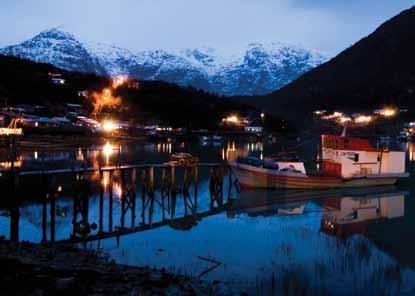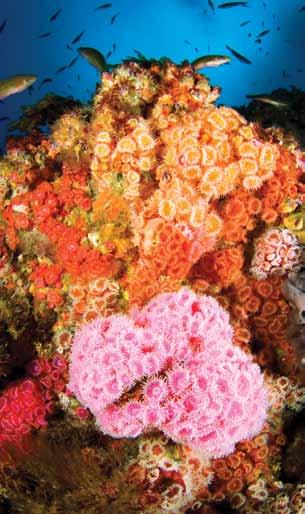
3 minute read
Expeditions
Oceana had a busy year on the water in 2009. Ranger sailed to the Canary Islands to make the case for greater protections for the Canaries’ unique marine ecosystem by gathering neverbefore-seen underwater footage. In Chile, Oceana returned to the cold-water fjords of Patagonia to gather evidence for a marine reserve in the region. Oceana’s divers, photographers and campaigners also campaigned on behalf of Chile’s storied Juan Fernández Archipelago and Punta de Choros, a biodiversity hotspot threatened by the proposed development of coal-fired plants.
RANgER MAkES THE CASE FOR PROTECTINg THE CANARy ISLANdS
Oceana’s research catamaran, Ranger, made it clear why the Canary Islands must be protected in its 2009 expedition. Currently, only 0.15 percent of the islands’ sea surface is protected and much of underwater ecosystem was unexplored prior to the Ranger’s efforts, despite its history as a stopping point for ships to the Americas from the time of Columbus.
The Ranger used an underwater robot to gather images almost 2,000 feet below the surface of the sea. It discovered a dozen species never before seen in the waters of the Canaries, including three-foot-tall glass sponges, Venus flytrap anemones and lollipop sponges.
Oceana’s video and findings will be used to demonstrate why marine reserves should be established on the Canaries as part of Spain’s efforts to meet the U.N. Convention on Biological Diversity goal of protecting at least 10 percent of the global marine environment by 2012.
An Oceana report on the state of the Canary Islands’ seabeds will be published in 2010.
CREATINg A RESERVE IN THE FjORdS OF PATAgONIA
In the spring of 2009, Oceana took its third and fourth expeditions to the pristine fjords of Tortel, Patagonia, advancing its campaign to establish a protected marine reserve there to protect against the encroachment of the salmon farming industry.
The crew gathered underwater photographs and shot an HD documentary in the remote region of Chile. Using an underwater robot, the crew was able to identify approximately 151 species.
With the strong support of the community of Tortel, Oceana and local authorities formally submitted a proposal to establish a Marine-Coastal Protected Area to Chile’s National Environmental Commission.
SAVINg RARE PENguINS ANd MORE FROM COAL-FIREd POwER PLANTS
Oceana completed several expeditions to Punta de Choros in northern Chile to document the area’s rich biodiversity in order to protect it from the proposed construction of two coal-fired power plants.
The islands include the Choros-Damas Marine Reserve, which hosts the world’s largest breeding populations of endangered Humboldt penguins, a colony of resident bottlenose dolphins, sea otters, blue whales and the economically important Chilean abalone.
A coal-burning power plant, which is proposed to be built less than 12 miles from the reserve, would significantly increase carbon dioxide and mercury emissions in Chile, elevating ocean water temperatures in the plant’s discharge areas, boiling marine microorganisms and depositing coal dust into the atmosphere and sea.
PROTECTINg THE juAN FERNáNdEz ISLANdS FROM bOTTOM TRAwLINg
In 1704, sailor Alexander Selkirk became marooned on an island off the coast of Chile and survived there for more than four years, inspiring the classic novel Robinson Crusoe.
In early 2009, Oceana carried out its first expeditions to the island and its neighbors, which form Chile’s Juan Fernández Archipelago. The region’s seamounts are home to endemic species, such as the Juan Fernández fur seal, found nowhere else in the world.
The expedition crew collected underwater videos and photographs and established contacts with the local communities on Robinson Crusoe Island. Local authorities expressed support for Oceana’s initiative to close the area’s seamounts to the industrial trawling fleet, which operates a mere five miles offshore.
In April, five prominent Chilean senators sponsored a bill to identify vulnerable marine ecosystems and ban bottom
trawling on them. The proposal was based on Oceana’s proposal, and if passed by Congress, will result in the immediate closure of 118 seamounts as a precautionary measure. It will also require that all trawlers have scientific observers on board.
A month later, Oceana convinced Chile’s Undersecretary of Fisheries to disclose information on the area of the exclusive economic zone impacted by the trawling fleet in Chile, which showed extensive damage on the seamounts near the Juan Fernández Islands.
© OCEANA | Carlos Suárez



OPPOSITE: Ranger and its ROV in the Canary Islands in 2009. TOP: Loggerhead turtle in the Canary Islands. LEFT: Sea anemones in the Juan Fernández Islands. RIGHT: The village of Tortel in the fjords of Chilean Patagonia.







